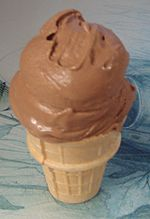Introduction
Ice cream is a type of frozen dessert that can either be factory-manufactured or home-made. Ice cream can be made of several ingredients but the core ingredients are cream, sugar and additives such as flavouring. In the case of Chocolate ice cream, the flavouring added is normally chocolate. Chocolate ice cream is the second most common type of ice cream in the world after vanilla.
As a matter of fact, chocolate-flavoured ice creams have been in existence for the past one hundred years becoming very popular among the citizens of the United States of America. Chocolate ice cream is made by whipping a mixture of cream, cocoa powder, eggs, sugar and vanilla and then having the blend frozen (Brown, 2005, p.1).
The end product is usually a chocolate-looking frozen cream as shown in the fig. 1 below. Most of the ingredients and additives used to make chocolate ice cream are not known to have any allergenic characteristics thus making the product consumable by many.

Packaging and the Shelf-Life of Chocolate Ice Cream
There are several ways of packaging chocolate ice cream which include: plastic cups, plastic containers and jars, glasses and cones just to mention a few. The packaging of chocolate ice cream depends on the time of use for instance if it is to be eaten immediately, it could be served in cones, cups or glasses. For future use, it is kept in closely fitted containers. During shipping or transportation, the chocolate ice cream is normally frozen and stored in refrigerators or carbonated ice containers.
Given its composition, chocolate ice cream is self-preserving thus preservatives are only added in limited cases. This is because the presence of sugar in the mixture increases the osmotic pressure thus making it difficult for microorganisms to survive in there. The second preservation method is the low temperatures in which the ice cream is manufactured and kept thus hindering the activity of most microorganisms.
Consumers are always advised to store chocolate ice cream in frozen conditions if they are not using it at that time (Boyer and McKinney, 2009, p.1). This is meant to preserve it in addition to maintaining its frozen shape and condition. It goes without saying that for the chocolate ice cream to have its desired taste and mouth feel, it should be in frozen condition.
Uses and Sale of Chocolate Ice Cream
Chocolate ice cream has many uses ranging from it being just eaten in its original form as a desert. It could also be used to make chocolate icing in cakes, chocolate chips, cream pies and bonbons among other uses (Brantley, 2007, p.1). Given its different uses, chocolate ice cream could fall as a ready-to-eat product, heated before consumption for instance in cream pies or further processed to make other products such as the bonbons.
Chocolate ice cream can be sold in several places for instance in ice-cream parlours, supermarkets, candy shops and milk bars just to mention but a few.
Relationship to ISO 9001
ISO 9001 is a food safety management system which is essentially concerned with the production of quality goods and services. It is a quality management system in which an organization puts in place control measures and ways through which quality goods and services are produced to satisfy customers’ expectations (New Life, 2010, p.1).
The fact that chocolate ice cream is a food product; it should be produced under conditions that are ISO 9001 compliant. Clause 7 of the ISO 9001 is on product realization requirements whereby a manufacturer of a food product is concerned with giving the best to its customers. A chocolate ice cream manufacturer could ensure that this clause is realized by having their employees well conversant with the ISO 9001, considering customer feedback as well as suggestions from the customers on product improvement.
Reference List
Boyer, R. and McKinney, J. (2009). Food Storage Guidelines for Consumers. Web.
Brantley, A. (2007). Eight Uses for Ice Cream. Web.
Brown, A. (2005). Chocolate Ice cream. Web.
Elinor, D. (2007). Chocolate Ice cream. Web.
New Life. (2010). ISO 9000. Web.